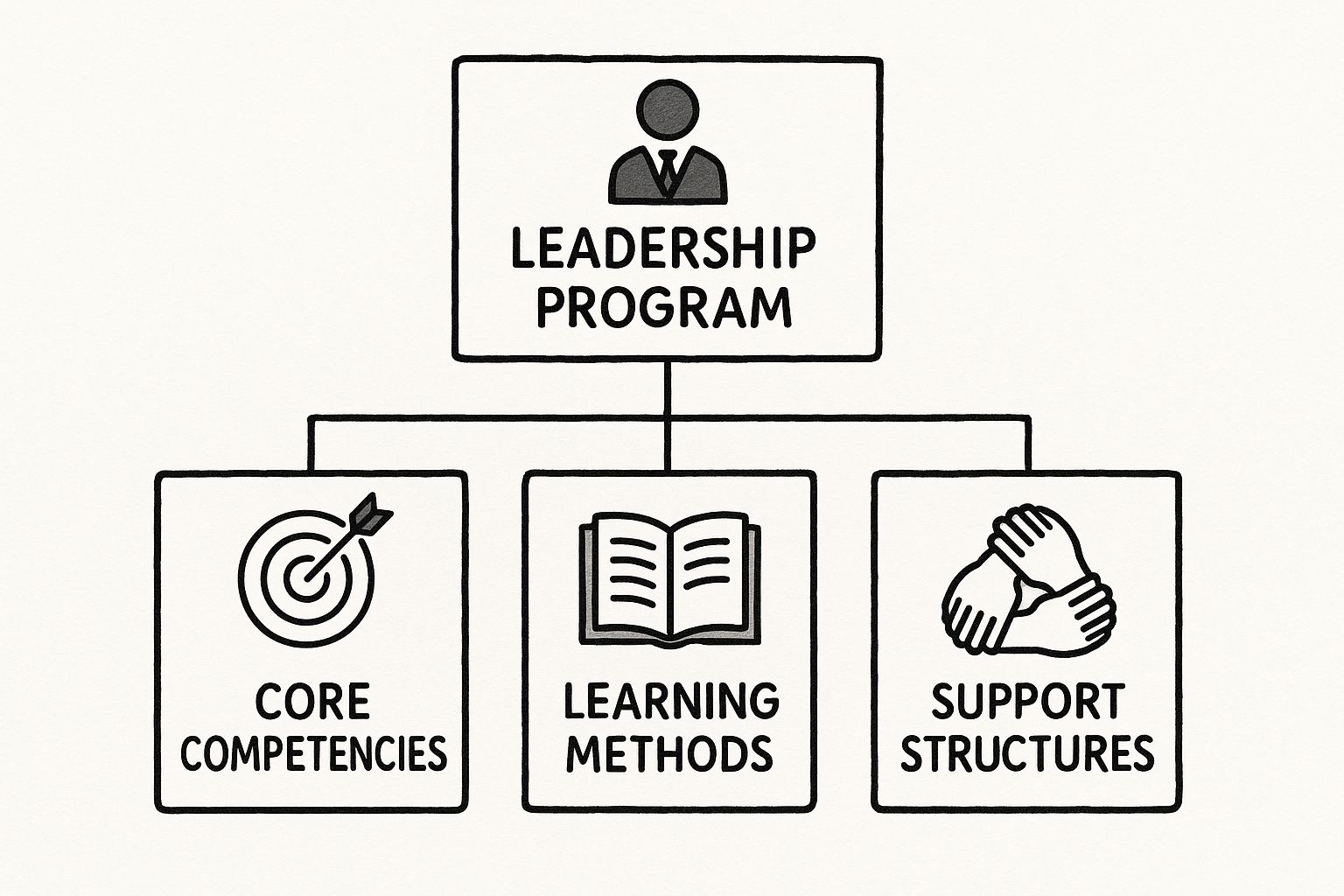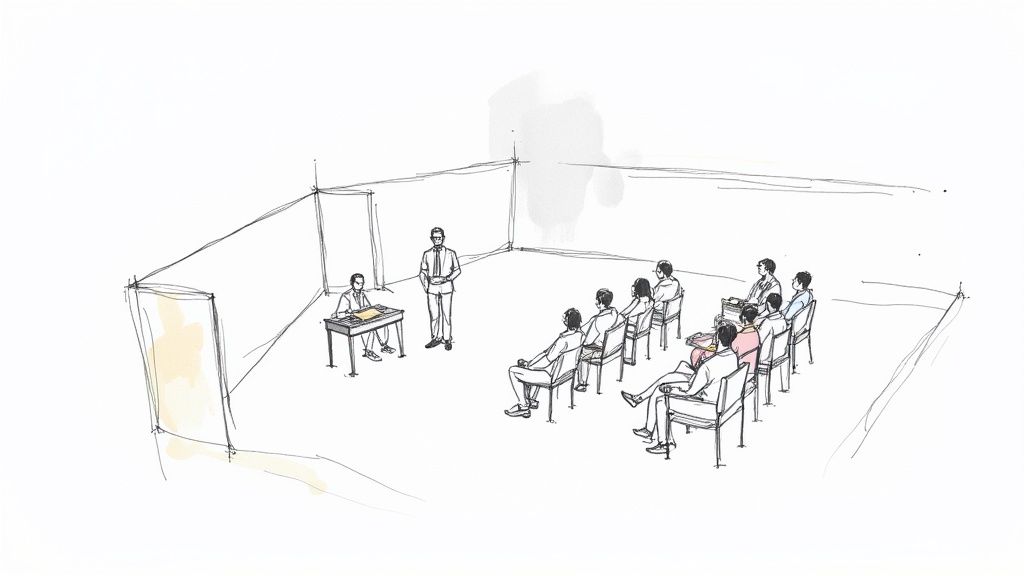Summary:
Leadership development has become a strategic priority for businesses aiming to thrive in a rapidly changing world. Effective programs focus on cultivating essential skills like strategic thinking, emotional intelligence, and communication, while integrating mentorship, experiential learning, and continuous feedback. Tailored models, such as the 70-20-10 and Situational Leadership, ensure programs align with company culture and strategic goals. In tech industries, agile learning methods and tech-centric competencies are crucial. Modern leadership training emphasizes diversity, inclusion, and human-centric skills to address challenges like burnout and trust deficits, ultimately fostering resilient and adaptable leaders.
Table of Contents
In a world of constant change, leadership is less about a title on an org chart and more about a core capability that decides whether a company wins or fades away. That’s why leadership development programs have moved from the "nice-to-have" HR column to a non-negotiable strategic priority for any business serious about its future.
Why Leadership Development Programs Are a Strategic Imperative

Think about the best sports teams-the ones that build dynasties. They don’t just splash cash on star players. They systematically build from the ground up. They invest in their coaches, their captains, and their most promising young talent to create a culture of winning that lasts.
Businesses are no different. Companies that only think about leadership when a crisis hits are always playing catch-up. In contrast, those with strong, intentional leadership programs are the ones shaping their own destiny.
Building a Sustainable Advantage
Putting real resources into leadership development is a direct investment in your company’s long-term health. These programs are where you forge the skills your people need to handle ambiguity, spark new ideas, and truly inspire their teams. When you make a conscious effort to grow your leaders, the positive effects ripple through every corner of the business.
This isn't just a hunch; it's a global business reality. Worldwide spending on leadership training was recently pegged at around $85.81 billion, with forecasts showing it could hit $185.20 billion by 2032. That staggering number tells a clear story: businesses everywhere understand that homegrown leadership is the ultimate competitive edge.
The Tangible Business Outcomes
Good leadership development isn't just about soft skills and theory; it’s about driving hard, measurable results. Companies that get this right see concrete improvements in a few critical areas:
- Improved Employee Retention: People don't leave bad companies; they leave bad bosses. When managers know how to coach, communicate, and support their people, morale goes up, and top talent sticks around.
- Enhanced Innovation: The best leaders create a sense of psychological safety. This gives their teams the confidence to experiment, take smart risks, and even fail without fear-which is the only way real innovation happens.
- Greater Agility: Markets shift and new challenges pop up overnight. Leaders who have been trained to think on their feet can guide their teams through the chaos, making smart, quick decisions that keep the business moving forward.
It’s important to see how this fits into the bigger picture; developing leaders from within is a perfect partner to a comprehensive talent acquisition strategy.
A leadership development program is the engine of organizational resilience. It prepares your people not just for their next promotion, but for the company's next unforeseen challenge, ensuring you can adapt and thrive no matter what the future holds.
Ultimately, these programs give you a deep bench of talent. Instead of panicking when a key role opens up, you have a pool of capable, prepared people ready to step in and lead. This kind of foresight is what separates the true market leaders from everyone else. For a deeper dive, our thoughts on https://matthewmamet.com/blog/leadership can offer more perspective.
Ready to drive more growth & achieve bigger impact?
Leverage my 25+ years of successes and failures to unlock your growth and achieve results you never thought possible.
Get StartedThe Anatomy of a High-Impact Leadership Program
So, what separates a leadership program that actually works from a forgettable seminar that just checks a box? The best ones aren't just a collection of random workshops. They're carefully designed systems where every part works together.
Think of it like building a high-performance car. A monster engine is useless without a strong chassis to handle the power. An amazing navigation system doesn't matter if the steering is shot. The same logic applies to building great leaders.
A truly effective leadership development program always has four key components. Each one has a specific job, but their real magic comes from how they connect to create a complete growth experience. This blueprint is a fantastic way to either size up an existing program or design your own from scratch.
Core Skills Training: The Engine
This is the raw horsepower of any leadership program. Core skills training is where your leaders get the fundamental tools they need to drive their teams-and the business-forward. We're not talking about fuzzy theories here, but practical skills they can use every single day.
This foundational training usually covers a few key areas:
- Strategic Thinking: The ability to look up from the daily grind and see the bigger picture. How do our team's actions connect to the company's overall goals?
- Emotional Intelligence (EQ): This is huge. It’s about understanding your own emotions and, just as importantly, reading and influencing the emotions of others. The data is clear: leaders with high EQ build teams that are more engaged and resilient.
- Communication and Influence: Mastering the art of getting your point across clearly and persuasively. This is essential for aligning teams, managing stakeholders, and getting people excited to follow your lead.
Without this engine, a leader is stuck in neutral. No amount of experience or support can make up for a lack of these core competencies.
Mentorship and Coaching: The Chassis
If skills training is the engine, think of mentorship and coaching as the chassis-the sturdy frame that gives a leader stability and support. This is the structure that holds everything together, making sure all that horsepower from the engine is channeled properly and doesn't spin out of control.
A strong support system is absolutely non-negotiable. Mentors bring wisdom and perspective, sharing stories from their own careers to help emerging leaders navigate tricky situations and office politics. They offer that long-range view that can shape a leader’s entire career.
Ready to drive more growth & achieve bigger impact?
Leverage my 25+ years of successes and failures to unlock your growth and achieve results you never thought possible.
Get StartedCoaching is a bit different; it’s more focused on immediate performance. A great coach helps a leader spot their blind spots, refine how they tackle challenges, and find their own solutions. This is where the theoretical knowledge from the classroom gets turned into real, on-the-ground capability.
You don't build a great leader in a classroom alone. They are forged by learning new skills and then getting personalized guidance from people who’ve already walked the path.
Experiential Learning: The Navigation and Traction Control
Now we get to the fun part. Experiential learning is like the advanced navigation and traction control system that guides a leader through real-world terrain. This is where theory gets put to the test. It's one thing to talk about making a tough strategic call in a workshop; it's another thing entirely to make one when real money and people's jobs are on the line.
These hands-on experiences are designed to push leaders right out of their comfort zones. It forces them to apply what they've learned in messy, unpredictable scenarios, which is how the lessons really stick.
This can take a few different forms:
- Stretch Assignments: Putting a leader in charge of a critical project that’s just a little beyond what they’ve done before.
- Business Simulations: Interactive games where teams run a virtual company, making tough trade-offs on everything from marketing spend to R&D, and seeing the immediate results.
- Cross-Functional Projects: Tasking a leader with an initiative that requires them to get buy-in from people in other departments, teaching them how to influence without having direct authority.
Feedback and Assessment: The Dashboard
Finally, you need a dashboard. Continuous feedback and assessment give a leader the real-time data they need to know if they're on track. A driver needs to see their speed, fuel level, and engine warnings to operate a car safely and effectively. In the same way, a leader needs clear, constant information on their performance to improve.
This component closes the loop on the entire process. It’s what builds self-awareness and allows for course correction. Without it, leaders are just driving blind, completely unaware of how their actions are really landing. A solid feedback system often includes 360-degree reviews, performance metrics, and regular check-ins, making sure that growth is both intentional and measurable.
Choosing the Right Leadership Development Model
Not all leadership development programs are cut from the same cloth, mainly because no two companies are heading in the same direction. Picking the right model is a bit like choosing a training regimen for an athlete-you wouldn't train a marathon runner and a powerlifter the exact same way. The key is to land on a framework that genuinely reflects your company's culture and what you're trying to achieve strategically.
This isn't about blindly adopting a rigid set of rules. It’s about committing to a core philosophy of how you believe leaders are best grown in your specific environment. When you get this right, you avoid the generic, one-size-fits-all programs that rarely produce the kind of leaders you actually need to win.
A solid structure gives your program a clear sense of purpose, blending essential skills with proven learning techniques and a strong support system.

As you can see, a great program is a well-oiled machine where what leaders learn (competencies), how they learn it (methods), and the environment they're in (support) all click into place.
Let’s dig into a few popular models that bring these elements to life.
The 70-20-10 Model
The 70-20-10 model has been a mainstay in corporate training for good reason. It’s less of a strict formula and more of a practical gut-check on how people really learn and grow on the job. The whole idea is that leadership development is stickiest when it mirrors how we naturally absorb new skills.
Think about learning to cook. You can read all the cookbooks you want, but you don't become a great chef until you get your hands dirty in the kitchen.
This model breaks that idea down:
- 70% Experiential Learning: This is the hands-on, in-the-kitchen work. It's all about tackling tough assignments, leading new projects, and learning from the occasional flop in real-time.
- 20% Social Learning: This is learning from other cooks. It happens through mentorship, coaching, and simply observing seasoned pros, picking up insights through conversation and collaboration.
- 10% Formal Learning: These are your cookbooks and cooking shows. This piece covers the structured training-workshops, online courses, and books-that provides the essential theory and foundation.
This model is a natural fit for organizations that believe leaders are made, not just trained. It thrives in cultures where people are encouraged to roll up their sleeves and learn by doing, forging pragmatic and resilient leaders along the way.
The Situational Leadership Model
Developed by Paul Hersey and Ken Blanchard, the Situational Leadership model is built on a simple but powerful idea: there is no single "best" way to lead. The most effective leaders are chameleons, able to adapt their style to fit the person and the situation in front of them.
Picture a great coach. They don't give the same pep talk to a seasoned quarterback and a rookie wide receiver. The coach instinctively assesses each player's confidence and skill level, then adjusts their approach to deliver just the right blend of direction and encouragement.
Ready to drive more growth & achieve bigger impact?
Leverage my 25+ years of successes and failures to unlock your growth and achieve results you never thought possible.
Get StartedThis model trains leaders to do the same thing-to become perceptive and incredibly flexible. They learn to diagnose where a team member is on their development journey for a specific task and then apply one of four distinct leadership styles:
- Directing: For someone who is enthusiastic but new to the task. The leader gives clear, step-by-step instructions.
- Coaching: For team members who are still learning and might be feeling a dip in motivation. The leader still gives direction but also explains the "why" and cheers them on.
- Supporting: For people who have the skills but might lack the confidence. The leader shifts to a facilitator role, empowering them to take the lead.
- Delegating: For team members who are experts and highly motivated. The leader steps back, trusts them completely, and gets out of the way.
This approach creates leaders who are masters of empathy and influence. They get good at developing their people because they're laser-focused on giving each person what they need to grow. After all, real leadership confidence isn't about having one go-to style, but knowing how to flex.
This model truly shines in dynamic, people-first environments where employee growth is a core business strategy.
Comparing Leadership Development Models
To help you find the right fit, it’s useful to see these models side-by-side. Each has a different center of gravity and works best in certain types of company cultures.
| Model | Core Focus | Best For Environments That Value... |
|---|---|---|
| 70-20-10 Model | Learning through experience, with support from social and formal training. | Hands-on problem-solving, autonomy, and learning by doing. |
| Situational Leadership | Adapting leadership style based on an individual's development level. | Employee growth, flexibility, empathy, and coaching. |
| Transformational Leadership | Inspiring and motivating teams to innovate and create change. | Innovation, rapid growth, and a strong, shared vision. |
| Servant Leadership | Prioritizing the needs of the team to foster growth and well-being. | Collaboration, community, high trust, and employee empowerment. |
Ultimately, the "best" model is the one that feels like an authentic extension of your organization's values and actively helps you build the specific leaders you'll need for the future.
Designing Programs for High-Stakes Tech Leadership

Leading a software company is a different beast entirely. The ground is constantly shifting under your feet as new technologies emerge, startups disrupt the status quo, and customer expectations evolve seemingly overnight. This is why generic leadership development programs so often miss the mark-they just weren't built for the specific pressures of this high-stakes world.
If you want to build leaders who can actually steer a modern software company through the storm, your program needs to be designed with the realities of tech baked in from the start. It has to go beyond standard management theory and cultivate the precise skills needed to lead in an environment defined by constant change and a fierce war for top talent.
Identifying Tech-Centric Competencies
Before you even think about curriculum, you have to define what a great tech leader actually looks like inside your organization. Sure, foundational skills like communication are universal, but leading in software demands a unique set of abilities. Think of this as mapping the DNA of your future executive team.
We often see a few core competencies rise to the top:
- Leading Through Ambiguity: The tech world rarely offers a complete picture. Leaders must be able to make confident decisions and set a clear direction with incomplete information-it’s the norm, not the exception.
- Data-Driven Decision Making: This means moving beyond gut feelings. Great tech leaders ground their strategic choices in product metrics, user behavior, and hard market data.
- Fostering Psychological Safety: Innovation doesn’t happen without it. Leaders need to create an environment where engineering and product teams feel safe enough to experiment, take smart risks, and even fail. That’s where the real breakthroughs come from.
- Managing Elite Technical Talent: Top-tier engineers and product managers aren't motivated by hierarchy. You need leaders who understand how to challenge, motivate, and retain brilliant people who are driven by impact, not just a title.
A successful program is built on a deep understanding of these non-negotiable skills. Without this focus, you risk developing managers who simply can’t connect with the very people they’re supposed to lead.
In the software world, leaders must be fluent in the language of innovation. This means creating a culture where curiosity is rewarded, intelligent failure is a learning opportunity, and the best ideas win, regardless of where they come from.
Implementing Agile Learning Methods
The way you teach has to mirror the industry you're in. A year-long, waterfall-style training program feels completely out of touch in a world that operates in two-week sprints. The most effective leadership development programs for tech leaders borrow their structure from agile principles.
Ready to drive more growth & achieve bigger impact?
Leverage my 25+ years of successes and failures to unlock your growth and achieve results you never thought possible.
Get StartedThis approach breaks development into smaller, iterative cycles, much like a software project. It's a rhythm of short bursts of focused learning, followed immediately by real-world application, and then closed out with reflection and feedback. This keeps the training relevant, timely, and directly useful for the challenges leaders are facing right now.
For instance, instead of a week-long offsite, an agile program might look like this:
- A half-day workshop on a specific skill, like "Giving Effective Technical Feedback."
- A two-week "sprint" where participants are tasked with deliberately applying that skill with their teams.
- A peer-coaching "retrospective" where small groups share what worked, what didn’t, and what they learned.
- Repeat the cycle with the next competency.
This methodology not only feels more intuitive to people from a tech background but also dramatically accelerates skill acquisition. It turns the workplace into a live learning lab where leadership is built and refined in real time.
Building a Curriculum That Resonates
Finally, the content itself has to be spot-on. A case study about a manufacturing company simply won't land with a VP of Engineering. Your curriculum must be filled with challenges and scenarios pulled directly from the software industry.
Try structuring modules around the problems they actually face:
- Navigating Technical Debt: Train leaders on the tough balancing act between short-term feature velocity and long-term platform health.
- Product Strategy and Vision: Help leaders shift from a project-execution mindset to one focused on market impact and strategic positioning.
- Scaling Teams and Culture: Prepare leaders for the immense challenge of growing their teams from 10 people to 100 without losing the "magic" that made them successful in the first place.
By designing a program that speaks the language of tech, pinpoints the right competencies, and uses agile methods, you build leaders who are doing more than just managing-they're shaping the future of your company. You create executives who can lead confidently through disruption and inspire the innovation that defines this entire industry.
The Evolution of Modern Leadership Training
To really get a handle on where leadership development is going, you have to look at where it's been. The training programs of the past-think mid-20th century-were pretty rigid, top-down affairs. They were built for a command-and-control world, designed to churn out managers who could enforce rules and keep things running exactly as they were.
That old model just doesn't cut it anymore. Today's programs have made a massive shift, moving away from creating cookie-cutter managers and toward cultivating leaders who are adaptive, empathetic, and inclusive. This isn't just a feel-good change; it’s a necessary strategic pivot for a business world that’s more complex and fast-moving than ever.
From Uniformity to Inclusion
A huge part of this evolution comes from a simple realization: diversity and inclusion aren't just buzzwords or social nice-to-haves. They're a massive competitive advantage. Early leadership programs naturally mirrored the homogenous corporate hierarchies of their time, but this created a huge organizational blind spot.
Smart organizations now know that teams with different backgrounds, experiences, and viewpoints are consistently more innovative and better at problem-solving. As a result, modern leadership programs are being deliberately built to find and grow talent from every corner of the company.
You can see a great example of this trend in higher education. The American Council on Education (ACE) Fellows Program, a highly respected leadership initiative, started in the 1960s with participants who were almost all white men. By its 40th class, however, the group of 38 fellows included 23 women and a large number of minority participants. This reflects a very intentional move toward more diverse leadership cohorts in educational programs.
Embracing Adaptive and Human-Centric Skills
Beyond who is in the room, the what of leadership training has also changed dramatically. The old focus on managing processes and overseeing tasks has given way to an emphasis on human-centric skills-the kind that help leaders navigate constant change.
The best programs today prioritize abilities like:
- Emotional Intelligence (EQ): The ability to not only understand and manage your own emotions but also to read and positively influence the emotions of others.
- Psychological Safety: The skill of building a team culture where people feel safe enough to speak up, ask questions, and even fail without fear of blame.
- Coaching and Mentorship: A fundamental shift from being a "teller" to being a "guide," focused on helping team members find their own solutions and grow.
This pivot is based on a fundamental truth: you can't command people to be innovative or loyal. You have to create the right environment for those things to flourish. It’s a concept that really highlights the value of coaching and leadership development for growth.
Modern leadership training is no longer about forging identical keys for existing locks. It's about giving emerging leaders a versatile toolkit to create new doors and pathways for their teams.
This journey from a one-size-fits-all script to a flexible, human-first playbook is what defines effective leadership development today. For a deeper dive into what's working now, check out the podcast L&D In Action: Winning Strategies From Learning Leaders. The programs that win are the ones that prepare leaders not for the world we knew, but for the one that is constantly unfolding.
Tackling Today's Biggest Leadership Challenges

Great leadership used to be all about hitting the numbers. Today, it’s about nurturing the people who actually drive that performance. But many companies are quietly grappling with a crisis that’s eating away at their core: a one-two punch of leader burnout and a massive erosion of workplace trust.
These aren't just HR buzzwords or signs of individual failure. They're serious organizational threats. If you let them fester, they’ll poison your culture, grind innovation to a halt, and cause your best people to walk out the door. The smartest leadership development programs are now being redesigned to tackle these deeply human challenges head-on.
Ready to drive more growth & achieve bigger impact?
Leverage my 25+ years of successes and failures to unlock your growth and achieve results you never thought possible.
Get StartedCombating Burnout and the Trust Deficit
The modern workplace can feel like a pressure cooker. We're navigating constant change, new technology, and never-ending demands. It’s no wonder leaders, especially those in the trenches, are feeling the heat. And this isn't just a feeling; a recent major study confirmed a widespread crisis of burnout and mistrust is pushing leaders out. Many are struggling to find meaning in their work, which tanks their effectiveness and makes them prime candidates to quit. You can explore the full findings on leadership effectiveness and retention for a deeper look.
This creates a vicious cycle. A burned-out leader simply can't build a high-trust team. Their stress and cynicism naturally trickle down, creating an environment where people feel insecure and unmotivated.
Trust is the currency of modern leadership. Without it, you just have a group of individuals working in parallel. With it, you have a cohesive team capable of achieving extraordinary things.
To break this cycle, companies have to get intentional about building leadership training that fosters resilience and rebuilds trust. That means getting beyond the spreadsheets and strategy decks to focus on developing the whole person.
Weaving Human-Centric Skills into Development
If you want to build healthier, more effective leaders, you need a new toolkit. This is where organizations can make a real difference, by weaving practices that support mental and emotional well-being directly into their development programs.
Here are a few actionable strategies that work:
- Mindfulness and Resilience Training: Give leaders practical tools to manage stress, stay focused in the moment, and keep their cool under pressure. This builds the mental armor they need to lead calmly through chaos.
- Mental Health First Aid: Train your leaders to spot the early signs of mental health struggles on their teams and respond with support, not judgment. This is fundamental to creating real psychological safety.
- Purpose-Driven Leadership: Help leaders connect the day-to-day grind to a bigger mission. When a leader is crystal clear on their "why," they can inspire their team with a sense of shared purpose that makes the work meaningful.
When you embed these elements into your leadership development programs, you’re not just creating high-performers. You’re cultivating leaders who are healthy, grounded, and able to build the authentic trust that modern teams need to thrive. That’s the ultimate competitive edge.
Frequently Asked Questions
When it comes to leadership development, a few practical questions always come up. Let's tackle the big ones about cost, impact, and what to expect.
How Do You Actually Measure the ROI of a Leadership Program?
This is the million-dollar question, isn't it? The truth is, you need to look at both the hard numbers and the softer, but equally important, behavioral changes. It’s a mix of art and science.
On the quantitative side, you can track specific key performance indicators (KPIs) before and after the program. Look for shifts in:
- Employee retention rates on the participants' teams.
- The promotion velocity of graduates versus their colleagues.
- Hard improvements in team performance and productivity.
- Positive jumps in employee engagement scores on company-wide surveys.
For the qualitative side, 360-degree feedback is your best friend. Getting input from a leader's manager, peers, and direct reports before and after the program provides a clear picture of whether specific skills have improved. Ultimately, the real proof is a stronger bench of internal leaders and the measurable business results they start delivering.
Can a Small Business Really Run a Good Leadership Program?
Absolutely. You don't need a Fortune 500 budget to create a high-impact program. It’s about being intentional and creative, not just throwing money at the problem.
Think of it as a grassroots movement. You can build something powerful by using what's already in-house. Start with structured mentorship, pairing seasoned leaders with up-and-comers. Use affordable online courses to build foundational skills. Facilitate peer-coaching circles where managers can troubleshoot real-world challenges together. Stretch assignments on critical projects are another fantastic, low-cost way to offer hands-on experience. Consistency trumps a big budget every time.
The most effective leadership development programs are a journey, not a single event. They are designed to create lasting change, not a temporary boost of motivation.
What Is the Ideal Length for a Leadership Program?
There’s no magic number, but one thing is certain: a single-day workshop isn't going to cut it for real behavior change. The most effective programs are designed as a sustained effort, typically running between six and 12 months.
This longer timeframe gives new skills a chance to stick. A common and effective structure starts with an intensive workshop, but then follows up with monthly coaching, ongoing project work, and a final capstone presentation. This approach gives leaders the space they need to try out new skills, fail, get feedback, and finally embed those new behaviors until they become second nature.
Are you a software executive or product leader looking to scale your impact? Matthew Mamet offers personalized coaching and strategic playbooks to help you master complex challenges and drive tangible growth. Learn how to accelerate your leadership journey.
Ready to drive more growth & achieve bigger impact?
Leverage my 25+ years of successes and failures to unlock your growth and achieve results you never thought possible.
Get Started



